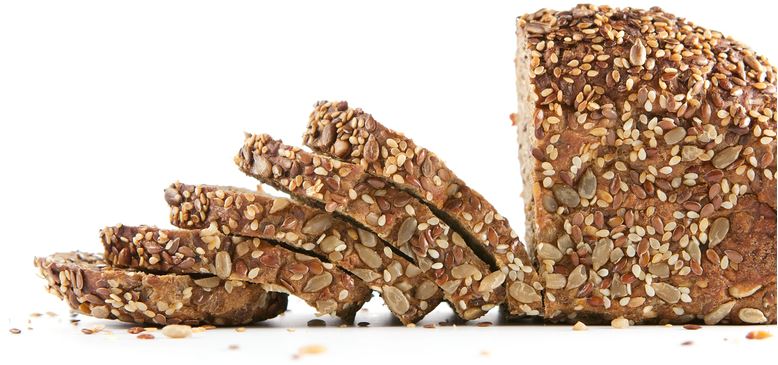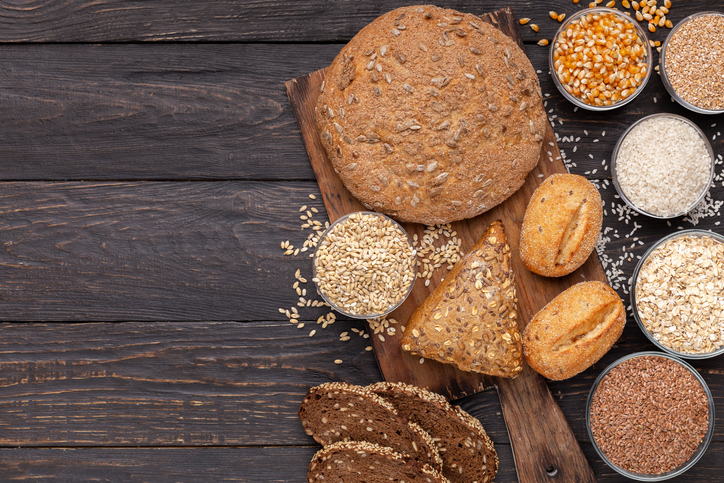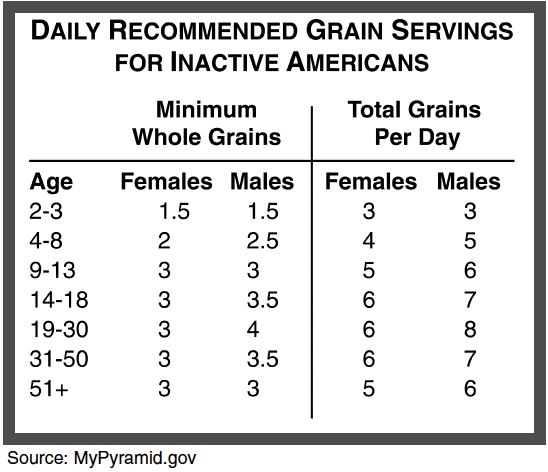The 2005 Dietary Guidelines for Americans are being revised and are slated to be released as the Dietary Guidelines for Americans, 2010
In the fall of this year. The 2005 Dietary Guidelines encourage Americans to “make half your grains whole.” But what exactly does this mean?
According to the DHHS and USDA’s President’s Food Safety Working Group, approximately 50 cents of every food dollar in the US is spent outside the home. With the knowledge that restaurants and ready-to-eat meals offer very few whole-grain options, dietitians and healthcare professionals urge Americans to increase whole-grain consumption at home. In this previous post, you can find a list of what is and what is not a whole grain.
When selecting whole-grain foods for home consumption, there are essentially three areas you can examine to determine whether or not a food is a good source of whole grain:
- Ingredient list: Look for the word “whole” in the first ingredient in the ingredient list; ingredients are listed in order by weight
- Dietary fiber: Look for foods that have 3 grams of fiber or more per serving (typically every 100 calories or 1 oz.)
- Grams of whole grain in foods that are a mix of whole and enriched grains: 16 grams of whole grain ingredients counts as a full serving
Food products are increasingly being labeled with grams of whole grain content. A whole-grain product has 16 grams of whole grain per serving, but you may see the Whole Grain Stamp listing half servings of whole grain (8 grams) per serving as well. Keep in mind that high fiber is not always the same as whole grain. Many foods have isolated or functional fibers added to traditionally low fiber, enriched grain products.
The Grains group in MyPyramid.gov and the American Dietetic Association recommend that inactive Americans have the following total number of grains per day and that half of these be whole grains:
The American Dietetic Association’s Nutrition Fact Sheet “Whole Grains Made Easy” recommends incorporating some of the following foods into your daily routine in an attempt to “make half your grains whole”:
- Whole-grain bagel
- Popcorn
- Brown rice
- Whole grain pasta
- Oatmeal
- Wild rice
- Whole grain English muffin
- Whole grain veggie burger
- Bulgur pilaf
- Barley mushroom soup
- Whole grain pizza crust
Tips for Incorporating Whole Grains in Your Daily Diet

Following are some tips for incorporating whole grains into your diet:
1. The Simple Breakfast Switch
One of the efficient ways to make your half grains whole is to switch the refined grain bread with the whole-grained one. You can easily get 100% whole wheat bagels or bread for your sandwiches in the mornings. Spread the smooth avocado spread or a peanut butter blend, and you are good to go!
2. Healthy Snacking
Popcorns are listed as one of the best sources of whole grains as they are made of whole kernels. To ensure that your snacking is healthy, abstain from buying the packaged popcorn. Ge yourself a big bag of whole kernels and pop them on the stove or in the popcorn maker. You can also drizzle butter or cheese on your popcorns.
3. Mix Whole Grains in Dishes
You can also purchase whole grains and prepare them by soaking them overnight and boiling them beforehand. You can add them to various dishes, such as vegetable soup and stews. In addition, barley goes very well with soups and stews, while quinoa can be an excellent addition to the green salad or pilaf.
4. Whole Wheat Versions
There are numerous versions of food items made entirely of whole wheat. You can buy brown rice instead of white ones and make stuffed baked green peppers with tomatoes and cheese. You can also find whole wheat pasta and macaroni.
5. Whole Grains in Baking
There is no stopping you once you have your mind and heart set at switching to a healthier diet. The best way to do healthy baking is to use whole grains flour instead of the regular one. Try substituting buckwheat, oat, or millet flour and mixing it with the regular one to make healthy muffins, waffles, or pancakes.
Top Healthy Whole-Grain Foods

1. Whole Oats
100 grams of whole oats contain 10.6 grams and 16.9 grams of protein; hence, it is an excellent source of both.
2. Whole-Grain Bread, Cereals, and Pasta
Whole-grain breads, cereals, crackers, and pasta are usually more nutritious than refined flour alternatives. Not only are they a great source of fiber, but they also provide vitamins, minerals, and antioxidants.
3. Whole-Grain Rye
Whole-grain rye is a whole-grain product made from rye grains and contains no added preservatives or additives. It’s a very healthy food packed with nutritional benefits. Whole-grain rye can reduce cholesterol levels while lowering the risk of heart disease, cancer, and diabetes.
Whole-grain rye also contains more fiber than other grains, which can help keep you feeling full longer after eating. Rye bran contains significant amounts of vitamin B2, vitamin B3, selenium, and magnesium. Selenium and magnesium are important for cardiovascular health and prevent disorders such as Alzheimer’s disease.
4. Buckwheat
The hull of the buckwheat seed contains little grains that can be used as a cereal or as a grain in beverages. Buckwheat is most often eaten as a breakfast cereal and can also be used to make couscous, kasha (koh-sah), and bulgur.
Here are some ways you can use buckwheat:
- Cakes and biscuits: add to any recipe that calls for wheat flour. The bran and germ provide fiber.
- Bread: add to your regular bread recipe by replacing half of the flour with buckwheat flour; knead like usual, then let the dough rise until double in size.
- Pancakes and waffles: mix 1 cup buckwheat flour with 1 cup white flour mix before making your pancakes or waffles. You probably won’t need more than a cup of white flour for a batch of pancakes or waffles.
5. Quinoa
One of the healthiest whole-grain foods to eat, quinoa is a staple in many of the world’s most popular cuisines and offers a host of benefits — not only for your diet but also for your overall health and well-being.
Quinoa is an ancient, delicious superfood packed with protein and fiber, as well as other vitamins and minerals. It’s also an excellent source of protein with all nine essential amino acids, which means it provides all the amino acids our bodies need to function properly.
6. Millet
Millet is a tiny grain that is easy to grow and high in protein, fiber, and other nutrients. Many people are still unaware of this grain’s versatility and health benefits. But with the increased popularity of gluten-free diets, which have been linked to improved health in many people, millet is becoming more recognized by consumers.
The grain’s main use is as animal feed, but it also has uses as human food. Millet can be ground into flour or used to make things like porridge and even beer or wine.
Whole Grains for a Healthier Diet
Whole grains do not go through the refining process, which is why they are packed with minerals, vitamins, large amounts of phytochemicals, and fiber. Whole grains are the best sources of dietary fiber for our bodies. Fiber helps keep the digestive system upbeat while also preventing the body from various chronic illnesses.


